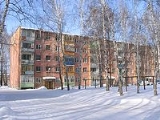
Khrushchovka
Encyclopedia
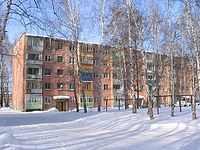

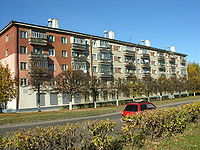
Panel building
Panel building may refer to buildings of one of the following types:*Built of structural insulated panels*Built of pre-fabricated concrete blocks, named differently in various countries....
or brick three- to five-storied apartment building which was developed in the USSR during the early 1960s, during the time its namesake Nikita Khrushchev
Nikita Khrushchev
Nikita Sergeyevich Khrushchev led the Soviet Union during part of the Cold War. He served as First Secretary of the Communist Party of the Soviet Union from 1953 to 1964, and as Chairman of the Council of Ministers, or Premier, from 1958 to 1964...
directed the Soviet government.
History
Traditional masonryMasonry
Masonry is the building of structures from individual units laid in and bound together by mortar; the term masonry can also refer to the units themselves. The common materials of masonry construction are brick, stone, marble, granite, travertine, limestone; concrete block, glass block, stucco, and...
is labor-intensive; individual projects were slow and not scalable to the needs of overcrowded cities. To ameliorate a severe housing shortage, during 1947-1951 Soviet architects evaluated various technologies attempting to reduce costs and completion time. During January 1950 an architects' convention, supervised by Khrushchev (then the party director of Moscow
Moscow
Moscow is the capital, the most populous city, and the most populous federal subject of Russia. The city is a major political, economic, cultural, scientific, religious, financial, educational, and transportation centre of Russia and the continent...
), declared low-cost, quick technologies the objective of Soviet architects. Two concrete plants were later established in Moscow (Presnensky, 1953; Khoroshevsky, 1954). By this time, competing experimental designs were tested by real-life construction, and prefabricated concrete panels were considered superior. Other possibilities, like in situ concrete, or encouraging individual low-rise construction, were discarded.
During 1954-1961, engineer Vitaly Lagutenko
Vitaly Lagutenko
Vitaly Pavlovich Lagutenko was a Soviet architect and engineer. His studies of low-cost prefabricated concrete construction, supported by Nikita Khrushchev, lead to a complete switch of Soviet building practice from masonry to prefab concrete...
, chief planner of Moscow since 1956, designed and tested the mass-scale, industrialized construction process, relying on concrete panel plants and a quick assembly schedule. During 1961, Lagutenko’s institute released the K-7 design of a prefabricated 5-storey building that became typical of the Khrushchyovka. 64,000 units (3,000,000 m2) of this type were built in Moscow from 1961 to 1968. In Moscow, space limitations forced a switch to 9 or 12-story buildings; the last 5-storey Khrushyovka was completed there during 1971. The rest of the USSR continued building Khrushyovkas until the end of communism; millions of such units are now past their design lifetime.
Design
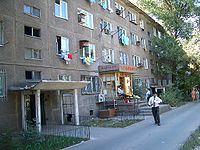
Elevator
An elevator is a type of vertical transport equipment that efficiently moves people or goods between floors of a building, vessel or other structures...
s were considered too costly and time consuming to build, and according to Soviet health/safety standards, five stories was the maximum height of a building without an elevator. Thus, almost all Khrushyovkas have five stories.
Khrushchyovkas featured combined bathroom
Bathroom
A bathroom is a room for bathing in containing a bathtub and/or a shower and optionally a toilet, a sink/hand basin/wash basin and possibly also a bidet....
s. They had been introduced with Ivan Zholtovsky
Ivan Vladislavovich Zholtovsky
Ivan Vladislavovich Zholtovsky was a Russian-Soviet architect and educator. He worked primarily in Moscow since 1898 till his death. An accomplished master of Renaissance Revival before the Russian Revolution of 1917, later he became a key figure of Stalinist architecture.-Early years:Ivan...
's prize-winning Bolshaya Kaluzhskaya building, but Lagutenko continued the space-saving idea, replacing regular-sized bathtubs with 120 centimeter long "sitting baths". Сompleted bathrooms cubicles, assembled at a Khoroshevsky plant, were trucked to the site; construction crews would lower them in place and connect the piping. Some theorists even considered combining toilet bowl functions with the shower's sink, but the idea was discarded. Kitchens were also small, usually 6 square meters. This was also common for many non-elite class Stalinist houses, some of which had dedicated dining rooms.
Typical apartments of the K-7 series have a total area of 30 m2 (1-room), 44 m2 (2-room) and 60 m2 (3-room). Later designs further reduced these meager areas. Rooms of K-7 are "isolated", in the sense that they all connect to a small entrance hall, not to each other. Later designs (П-35 et al.) disposed with this "redundancy": residents had to pass through the living room to reach the bedroom. These apartments were planned for small families, but in reality it was not unusual for three generations of people to live together in two-room apartments. Some apartments had a "luxurious" storage room. In reality, it often served as another bedroom, without windows or ventilation.
This "cookie-cutter
Tract housing
Tract housing is a style of housing development in which multiple similar homes are built on a tract of land which is subdivided into individual small lots...
" architectural method is satirized by the 1975 Soviet
Cinema of the Soviet Union
The cinema of the Soviet Union, not to be confused with "Cinema of Russia" despite Russian language films being predominant in both genres, includes several film contributions of the constituent republics of the Soviet Union reflecting elements of their pre-Soviet culture, language and history,...
comedy movie
Comedy film
Comedy film is a genre of film in which the main emphasis is on humour. They are designed to elicit laughter from the audience. Comedies are mostly light-hearted dramas and are made to amuse and entertain the audiences...
Irony of Fate
Irony of Fate
The Irony of Fate, or Enjoy Your Bath! is a Soviet comedy-drama directed by Eldar Ryazanov as a made-for-TV movie. The screenplay was written by Emil Braginsky and Ryazanov, loosely based on Ryazanov's 1971 play Once on New Year's Eve . For distribution outside of the Soviet Union, the film was...
or Enjoy Your Bath directed by Eldar Ryazanov
Eldar Ryazanov
Eldar Aleksandrovich Ryazanov is a Soviet/Russian film director whose comedies, satirizing the daily life of the country, are very famous throughout the former Soviet Union....
, where a Moscow
Moscow
Moscow is the capital, the most populous city, and the most populous federal subject of Russia. The city is a major political, economic, cultural, scientific, religious, financial, educational, and transportation centre of Russia and the continent...
dweller was flown by mistake to Leningrad
Leningrad
Leningrad is the former name of Saint Petersburg, Russia.Leningrad may also refer to:- Places :* Leningrad Oblast, a federal subject of Russia, around Saint Petersburg* Leningrad, Tajikistan, capital of Muminobod district in Khatlon Province...
, the taxicab
Taxicab
A taxicab, also taxi or cab, is a type of vehicle for hire with a driver, used by a single passenger or small group of passengers, often for a non-shared ride. A taxicab conveys passengers between locations of their choice...
drove him to his home street address which happens to exist in Leningrad as well, and the house and the apartment, and even the key to the apartment are exactly the same as his own.
Present day
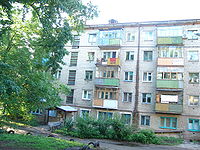
Communism in 20 years
Communism in 20 years was a slogan put forth by Nikita Khrushchev at the 22nd Congress of the Communist Party of the Soviet Union in 1961.In his speech, Khrushchev promised that communism will be built "in the main" by 1980. His phrase "The current generation of Soviet people will live under...
(by the 1980s). Later, Leonid Brezhnev
Leonid Brezhnev
Leonid Ilyich Brezhnev – 10 November 1982) was the General Secretary of the Central Committee of the Communist Party of the Soviet Union , presiding over the country from 1964 until his death in 1982. His eighteen-year term as General Secretary was second only to that of Joseph Stalin in...
promised each family an apartment "with a separate room per person plus one room extra", but many people continue to live in Khrushchyovkas today.
Khrushchyovka standard types are classified into "disposable", with a planned 25-year lifetime (сносимые серии) and "permanent" (несносимые серии). This distinction is important in Moscow and other affluent cities, where disposable Khrushchyovka are being demolished to make way for new, higher-density construction. The City of Moscow planned to complete this process by 2009. Less wealthy communities will rely on the aging Khrushchyovka stock indefinitely.
External links
- The Khrushchovkas The Ukrainian Observer
- Soviet-Era Housing Gets New Lease of Life The St. Petersburg Times

